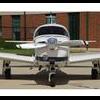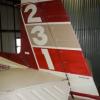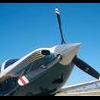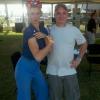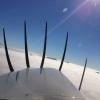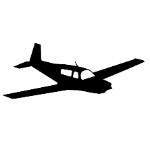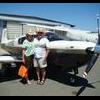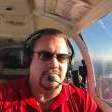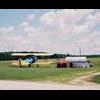Leaderboard
Popular Content
Showing content with the highest reputation on 04/23/2017 in all areas
-
I know exactly what you mean about the camera distorting our pictures. I think you had a setting wrong on your camera. Fixed it for you. Sent from my iPad using Tapatalk Pro6 points
-
I might be delusional but I feel the used c, e, and f market is just as important to general aviation as the new Mooney and Cirrus aircraft. It allows the middle class younger generation a chance to fly a fast certified plane which provides jobs to local mechanics, paint shops, etc ... MUCH more important than increasing shareholder values for a company in China.5 points
-
Flew from NW WA to SE WA (Walla Walla) to watch 13 year old granddaughter's softball tournament. Stopped in Pasco to pick up daughter-in-law and two grandkids for last 20 minute flight. Snake River and Tri-Cities looking west on the way home. There must be something wrong with my phone camera (and everybody else's) as I'm sure I look 20 years younger in the mirror4 points
-
Next he is going to tell us that they only provided the bare, essential services...2 points
-
Adjusted for inflation Modern airplanes (sans radios) are just about the same as they were in the 60's when you compare like for like. Liability is certainly a part of it but it gets over played quite a bit. It almost costs me less to insure my plane then my car and the coverage is much better. Cirrius has been successful largely because their manufacturing costs are very low in comparison to a Mooney. It also is a much better plane minus 15kts which for most isn't even noticeable.2 points
-
I do believe I understand the perspective of others, such as Godfather expressed for example that he felt "the used c, e & f market is just as important to GA as the new Mooney and Cirrus aircraft". The used vintage market is the entry point most newly minted pilots that want to own an efficient sleek sporty aircarft. But thanks to non-profit flying clubs that allow pilots to rent good aircraft at very competitive rates, the older J, K, M, R, S also provide entry to ownership to a lot of pilots that postponed ownership. I was one of those pilots who waited to enter aircraft ownership till I picked up my IR and had experience in different kinds of makes and models before deciding what I really wanted to own and acquired a K model. So i'd argue there is really no segment of the used aircraft market that is more important than any other, plus for any entry level buyer acquiring a vintage Moomey, there is the seller that is often moving up to a newer used Mooney. So to me,its the entire used market that is critical to GA.2 points
-
I do have the neighborhood boat ramp, though. And a view of the neighborhood pond that drains into the Lake. Just like I have an old Mooney in the hangar. If only there were more pilots around here . . . . Everybody has boats that cost more than my plane, yet I'm supposed to be the "rich airplane owner." Oh, well, at least I have a good plane, and I can still enjoy reading about the fancy new ones. It's fun to fly over the Lake and look at the traffic jams down there. Sometimes I'll go low and slow, just trolling along, then make a full power Vy climbout, just because I can.2 points
-
This forum and the Mooney name draws a lot of frugal individuals that will never own a new plane. Not because they can't afford the plane but because they feel it is a poor investment. People are less enthusiastic and often negative about things that are out of reach. Buying a used TBM, King Air, etc is a lot different than a new piston plane. Mooney pilots recommend having a spare 10k ready at all times to keep the bird in the air. With the mentioned turbo props you need to have at least 100k ready for this purpose. From what I've seen 1 out of 10 prospective buyers stopping by Mooney space are looking for planes north of 100k (most recently sub 50). This is a huge contrast to the buyers looking on other forms (cirrus/BT). Everyone would like a new or totally rebuilt Mooney to fly but very few think a company should charge enough to make a profit on this service. I'd love to have someone prove me wrong and put a deposit on a 300k refurbished J.2 points
-
Here is my favorite example. They land with the warning horn going off. All it takes is a distraction. It can happen to any of us. Paranoia and a multi check habit is probably the best protection.2 points
-
Mooney is anything but weak. But stopping the M10 after it was supposedly so close to certification is really scary. One the most recent milestones was a tentative agreement between the FAA and CAAC in China to provide joint FAA & CAAC manufacturing approval in China for it. As important as the M10 was to China it saddens me to see it stop as it must be for the 60-80 engineers that have been working so hard the last few years in Chino to get the plane certified. But I see no point in speculating on what we don't know. Soon enough we'll hear about details about the change in direction, which supposedly is for a bigger design. Meanwhile Soaring (Mooney in China) is co-hosting the annual airshow at Zhengzhou along with an airline at their Zhengzhou factory. Here are some shots as they prepare for the show opening on 27th. Their are many aviation businesses and aerobatic shows from around the world participating, but I am just including some Mooney specific photo's and short promotional video; and especially their two pilots I worked with there, Sonny and Sally IMG_3757.mp4 IMG_3758.mp4 BTW, there are few more photo's in my album if anyone is interested to see more.2 points
-
1 point
-
Non retract = inefficient, dumbed down and slow. Life limited airframe, higher insurance rates, and even if you love the chute, over a thousand dollars a year in repack before you fly one mile. The sales figures are undoubtedly in large part due to the chute. And finally poor handling and a bungee (spring cartridge) based trim system that has been theorized to be the source of pattern accidents by numbing slow speed handling. This is far from a superior product... imho. Sent from my iPhone using Tapatalk1 point
-
1 point
-
When my C got to turning over slowly, I put in a Concorde battery. For the next few months, I felt like I could taxi on the starter, it was turning so fast!1 point
-
The used market is far more important at this point to GA and it's future. Without it, there would be virtually no young GA pilots. Just military pilots, airline factory feeders and rich kids in daddy's "toy." economies of scale. To bring down the cost to where it "should be," we'd need to make flying more accessible and desirable. Move 100 times the aircraft through a factory, and they'd be much cheaper per unit, just like cars. The technology certainly isn't more complicated than a new Ford Fusion. It takes far fewer computers, wire bundles and sensors to build a mooney. Probably a little more aluminum, much less steel, though. And the engine is simpler in a mooney. The problem is the factory doesn't have the demand... so the unit cost is terribly high. sadly, flying GA is a hobby for most. An expensive one....1 point
-
Hugo, You got a lot of good advice in this thread, both about EGTs as well as the spot on advice by Kmyfm20's to check you max takeoff FF from as near sea level as you can. That is the first thing to check if you think your EGTs are high, as in excessively lean. But you never responded after you started the thread - instead you started another thread with a more general question? Lots of people willing to help here if you're willing to participate. FWIW, I can tell you are a very experienced pilot but without an exchange I don't know where to begin....1 point
-
1 point
-
In 1967 air travel was very expensive and did not have the expansive network we have today. General aviation was a real business tool and that in part drove growth. It is no small coincidence that right around deregulation the entire GA market fell apart. It wasn't the sole reason but certainly one of the drivers. If you look at the history of registration on planes it is amazing how high the percentage of business ownership was out there at one time. You see it some today but more often than not planes are a luxury like a boat and not a tool.1 point
-
@paul, the weakness in this particular quick drain is the geometry. There is an entrance hole at the top, then a relatively long barrel down to the seal mechanism, which apparently is a narrow, angled opening when it is unsealed. It is perfect for something long and skinny to enter and not pass through. @carusoam, if one were to maintain power the rings would not slap. I powered the engine down thinking that might save it for a little use if I came up short of the runway. You have to make choices, and I was not trying to save the engine. @cnoe, I think that might be true of NA's, but my experience is it is not true of the TSIO360. If you are going through oil there is a reason that is not good. @peevee, sorry.1 point
-
I don't anything about this unit but I would try to find someone who installed one before I committed. The FAA opened the door for these AoA indicators and I wonder how much testing was done by the manufacturers. I have the CYA unit and it too requires a calibration and I found I needed to do the calibration a few times to get it correct. As a side note, the CYA is vane based unit and doesn't use a pressure differential. It's actually a small flying wing. Sent from my iPhone using Tapatalk Pro1 point
-
Agreed. They go bankrupt and change CEOs faster than my girlfriend changes her mind of what she wants for dinner.1 point
-
I've flown to Williston on a number of occasions, although I was not there for the fly-in. The part of the field where the plane crashed is not visible from the ramp area at all so it wouldn't surprise me that people on the ground wouldn't see it. Some in the pattern may have spotted it depending upon how they entered the pattern. If you entered the pattern from a crosswind entry, you would have a better chance of spotting it than if you entered downwind on the 45. Once you were on base leg or final, you typically wouldn't be focused on the very far end of the field. You would be concentrating on your landing, particularly since it was reportedly a gusty day. Someone departing might have spotted it if they looked down while on climbout but I'm not sure that most of us would have a reason to be looking there at that time. I'm not trying to make excuses for what happened but like most of you, I'm just trying to understand what happened. One possible scenario is that he lost power during his climbout, turned left to attempt to return to the field, raised the nose attempting to stretch his glide over the trees to reach the runway and stalled it. But that is all conjecture. I wasn't there and we may never know the truth. It's just another very sad event.1 point
-
Low altitude often works for me. Above several thousand feet, I generally have no service. This has held true across the Midwest, over the Appalachians and through the Southeast. Sometimes if I'm near a medium size town, I can get a text out. Macon or Augusta, GA; Columbia or Greenville, SC; Knoxville, TN; these sometimes work 8500-10,000 msl; the Atlanta suburbs usually don't, I can tell etc close enough to town when always required to "remain clear of the Bravo." Eastern Kentucky has nowhere large enough to have much signal density . . . Low on approach, I can usually get one out even in the hinterlands, but always too close to the destination to alert anyone not already nearly there. I usually give them a call just before departure, advising of my expected arrival, because I know I can reach them then.1 point
-
Today's flight was a wash. Front moving through Texas today. Was supposed to go help load differently able kids for airplane rides at Conroe. Went to airport. Sat in Car and did weather stuff. Decided not to launch yet. A couple estate sales and walmart for a mouse. Back to airport. Got Al ready. Made about 10 minutes of a 20 minute flight and the ceilings lowered. Went down a little, then they lowered again. Turned around and went home. Hope the kids got their rides and a good time was had1 point
-
This is what I had hoped. This is the option for me. I have the 39 running to a 696 wired. It receives power from a cigarette lighter on far right of panel. Battery is back-up. Wires are well hidden. I like pilot and the 39 provides Bluetooth weather and what will be a better traffic picture. Thanks for the info. We have an old Narco at50 transponder so this is a nice upgrade. Active traffic would be nice, but no 430 installed so not a big deal to us. Thanks for quick answers everybody.1 point
-
I see the appeal for Scott to consider the 335. Installed 345s are going for $6,500 to $7,000 around here. Sent from my iPad using Tapatalk Pro1 point
-
The key thing is that if you go for the GTX-345 it will replace your GDL-39 and also provide ADHRS backup to your iPad. You would never have to be concerned with the battery of GDL-39 going dead. Then you just call on the GDL-39 as your last resort electrical failure backup; or even sell it to recoup some of the cost of the 345.1 point
-
As Don pointed out, the 335 will send the ADS-B out signal. It won't receive any "in" signals. The out signal will trigger the ground stations to send ADS-B back to your plane. Your GDL-39 will receive full TIS-B since you will always be in the hockey puck coverage of your own out signal and it will display on the iPad only. As before, you will always receive weather as FIS-B. The advantage of the 345 is it will display traffic/weather on your certified boxes and the Garmin portables. If that is not important to you, the 335 is a great way to go. Sent from my iPad using Tapatalk Pro1 point
-
1 point
-
If I had $900K I would be looking at a completely refurbished and 0 time Aerostar or a turbine Commander. It just isn't worth the money in my opinion considering other options out there.1 point
-
I have a sidewinder too and I really like it. I had no issue in the winter, nor when the pavement was wet. Sent from my iPhone using Tapatalk1 point
-
Good news. Hope it's not fake news. I have been holding off on a gtn650 install until I know I can get the double G5 package to go in at the same time and drive my AP.1 point
-
Chapter II. So, ok, it was not really the end, because our pilot and co-pilot woke up the next morning in a foreign country, called Can-something or other. The people there were friendly and helpful enough, the Fire Chief having been a good example. But this was not long after a not-so-magic event called "nine-one-one" and the pilot and co-pilot, never having intended to spend time with the good natured Canadian people, both lacked the magic they needed to get back to Kansas, aka their own country. The usual magic is passports and something new at the time called eAPIS codes, both of which the pilot had, but they were back in Kansas. So the next morning the pilot had to call a group of people in Kansas whose job it was to act gruff, and to huff and puff about things, to get back to Kansas. He talked to huffers and puffers in Buffalo, then Washington, and then in Ottawa, and finally one of them huffed and puffed and said, "I am going to have to call the CHIEF OF HOMELAND SECURITY, a large being in Washington, to see if we can let you back in to Kansas. I will call you back in an hour." An hour later, the phone rang and the huffer and puffer said that the large being in Washington had granted permission to come back to Kansas without penalty on one condition." "What condition" the pilot timidly asked. "You have to go to Buffalo, not Niagara, we don't have anyone in Niagara to wave their wand and let you in the gate." The pilot happily agreed, not remembering that Buffalo is a place where much larger magic carpets than his were present in large numbers. So the pilot and his co-pilot flew to Buffalo and landed between a really big magic carpet called something like "737" and another one called something like "MBraer" the pilot was really not paying attention he just knew they were really big, and went and saw the wand waver who huffed and puffed some more about why the pilot had not filed a magic eAPIS plan, but let the pilot in anyway. And of course, the pilots nifty airplane went into the shop some time later, where a mechanic said, "you have ring slap." Apparently, if a plane is put in a rapid descent (or dive, who knows) and the engine is powered down and the prop drives the engine rapidly, the nifty piston rings are not held against the nifty cylinder walls by nifty compression, and so they sort of rattle around. At any rate, the pilot got to have a mechanic shop do a nifty IRAN on the whole engine, which cost some sea shells to do, but that's ok because the engine ran alot better than it ever had and alot longer too. OK, now, The End.1 point
-
1 point
-
Once upon a time there was a pilot who had a nifty turbocharged aircraft equipped with a quick drain fitting that the mechanics all really appreciated. The pilot and his co-pilot were intending to fly from Minneapolis to Niagara, over Lake Michigan and in the twilight, to get there. When the pilot preflighted his nifty turbocharged aircraft he found one tiny dot of unfamiliar oil on the nose tire. So the pilot, being, he thought, a good, safe, above average pilot, had the plane wheeled into the shop for the mechanics to look at. The mechanics said, oh don't worry about it, it is just the quick drain dripping and they all do that. The pilot said, "Are you certain, because we are going to overfly Lake Michigan and with the delay to check the plane out, it will be in the dark." The mechanic said, "No problem, they just all do that." About two hours later the pilot had crossed the eastern shore of Lake Michigan, thankfully, and was at 19,000 with a nifty 75 knot tailwind, very pleased with himself, when a magic box called a JPI 930 spoke to him and said that his oil pressure was 14 lbs. "Uh, oh," the pilot though to himself, "it should be about 40 lbs." He tried a few things and it was still 14 lbs., so knowing what had happenned and what was going to come next (his oil was gone and the engine was going to freeze up and stop), and being blown by the nifty tailwind very quickly out over Lakes Erie and Huron (which are pretty big east to west), our pilot declared an emergency with Canadian ATC and put the plane in a rapid descent. Some would call it a dive, but let's not panic. The difficult part was that in the dark, over Canada, the nifty tailwind had also blown our pilot and his co-pilot into the back side of some weather, so the nifty dive, uh, rapid descent (who knows, the VSI was pegged), the pilot had to rely on some other magic boxes called "instruments" to make the passage to a lower altitude, without exceeding a magic speed called "Vne" where the plane would magically disappear, with the engine throttled back to save it if needed to make an airport, and to escape the nifty tailwind. Oh, and the next designated magic carpet landing area called "London, Ontario" was only 20 nautical miles distant, then more water. At one point, the co-pilot asked "Is there anything I can do," and the pilot, short on time, oil and alot of other things at that moment snapped "No" and so she (the co-pilot) shut up, for which the pilot was grateful. To make a long story short, our pilot was able to make a safe landing between the crash trucks at the end of the runway, the oil pressure having fallen to 6 psi. He taxied to the magic carpet ramp, where the Fire Chief climbed off the fire truck that had followed the pilot and his co-pilot in, took one look at the oil dripping off the entire underside of the aircraft, held out his hand, and said, "Nice landing, Captain." The pilot was not a Captain of anything on most days, but maybe on that day, he was. The very next day, another mechanic took the quick drain apart and found that a tiny piece of plastic that had been swimming around in the oil, had lodged in the quick drain, preventing it from completely sealing, and when the pilot ran is his nifty turbocharged engine the pressure in his nifty crankcase had caused all the nifty oil to blow out of his nifty engine. Well, almost all, it turned out that the tiny piece of plastic had a larger friend, a piece of rubber, that the plastic was swimming with. They must have been having a skinny dipping session. At any rate, when the oil got low enough, the piece of rubber had saved the last two quarts from departing. So the pilot and his airplane lived happily ever after, after all. So you just watch that quick drain. This has happened more than once, to more than one pilot, and the prior owner might have had his reasons for taking it out. Every year at annual, you should have your mechanic remove the quick drain and drain the oil through the big hole, to get all the skinny dippers out of the oil. Every few years you should have a "kit" installed so the quick drain is sealing well, so nothing this nifty ever happens to you. The End.1 point
-
Yes Anthony , and we ALL appreciate that..... Keep up the good work....... Concise , Succinct , to the point.......1 point
-
1 point
-
I wouldn't say we're not interested, but knowing I can't afford one means I focus my attention on the things I can afford.1 point
-
I was more focused on the idea of "if the autopilot is on, there's almost nothing to do" thought process of this young pilot...1 point
-
Absolutely I'll give you a ride. But you may have to play safety pilot while I shoot a practice approach or two. I'll send you a PM to see if we can coordinate. Sent from my iPad using Tapatalk1 point
-
These are "out of the box" Vans - right? With the James Holy Cowls Plenum makes an unbeatable installation. To bad it's a "no brainer" to everyone except the FAA! They should be aiding you to develop the STC - instead of beating you to death with regs and paper.1 point
-
Of course they would have ,pilots are reporting old "x"wrecks,forest fire smokes,abandoned river hulks..you name it...it's what we all do1 point
-
1 point
-
I mentioned in another post I had conducted my first donated medical flight in the Lancair for the mercy flight organization I am part of (actually President right now). Anyway, it was from KIMT (Iron Mountain, MI, in the U.P.) to Raleigh, NC (KRDU). I ended up with a STAR going in, then vectored around a Southwest Airbus heading west at 7,000' and they held me at 8'000' within 5 miles of the airport. When I could finally come down, I was getting vectors for a long downwind until I told them I could get down with no problem (a clear advantage with turbines). I was given 5L, which is the big runway. Not sure why 5R wasn't offered, as it ends right next to the GA FBO's. Anyway, after fueling and dropping the passengers off (and some distractions from ramp guys wanting to know about the plane) I got my clearance (SID of course, one not authorized for turbines????), started up and got taxi instructions. I was cleared to runway 5R (great news as I saw no activity on that runway, less stress). I taxied to the end, did a few quick items and changed to tower for my TO clearance. Just as I changed to tower, for some reason I looked back down the taxiway. There sits a Southwest Airbus less than 100 yards behind me. Holy crap they look big, that close, when your sitting in a 4 place GA plane! Needless to say I didn't delay my take-off. So much for getting the "quiet runway". Tom1 point
-
You would probably be money ahead selling your plane and buying a different one with everything installed. A WAAS GPS and an autopilot would likely run close to 30 AMUs. You would never get that back out of your plane, lucky to get 1/2. Here is one that looks good:1 point
-
I installed an STEC 60-2 way before I had a GPS in the panel. For me, although I could link it to fly a VOR or coupled with an ILS, the biggest advantage of the autopilot was being able to set the heading bug and altitude and keep myself fresh for when I hand flew the approach. Having flown for years in the northeast, just being able to let "George" fly while I am trying to sort out a new routing is well worth the investment. Sent from my iPad using Tapatalk Pro1 point
-
You really don't want to know what it cost to do the prototype! I try not to think about it too much, but I couldn't stand the way the front of my Mooney looked. It lowered the CHT's by 20 degrees F and I picked up 6 knots of speed. I hope to get a little more out of the cooling but carbureted engines run hotter than the IO's. I'm an A&P/IA and have a company that manufactures airplane parts and tooling, GDS Aero. I work for a corporate flight dept full time and then because I just can't get enough airplane stuff, do the other stuff in my spare time. I'm not really a die hard Cheese fan, but I do live for the Bears and Vikings to lose!! Must be pretty smart!1 point
-
I guess it's all good. I sold my 796 to a forum member after getting the GDL88. I primarily used it for traffic and weather. I'm just not use to flying with the 750, GDL88 and Ipad. Always had the 696 or 796 working in conjunction with. The portables all seem to give audible warnings for this or that. Thanks for the feedback. Glad all appears normal.1 point
-
In todays ePilot is a link to Engine and Prop short course, ASI credit. Note that inthe prop section it doesn't say anywhere that you "mustn't" pull on the prop when tugging the plane by hand. Of course lack of mention of something doesn't prove anything, but I just thought I'd note it here for argument sake. It does however have a neat pic of where stresses are on a rotating prop, ie max and min flex stresses... https://www.aopa.org/asf/osc/loginform.cfm?course=engine_prop&project_code=&WT.mc_id=120203epilot&WT.mc_sect=sap1 point


